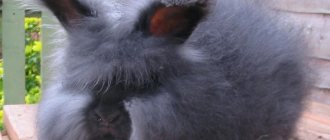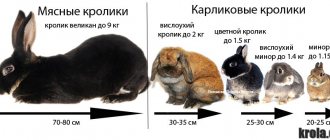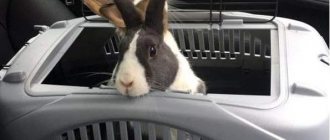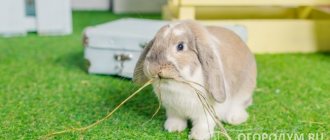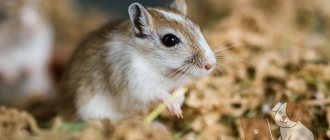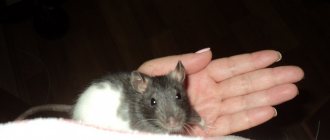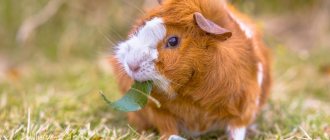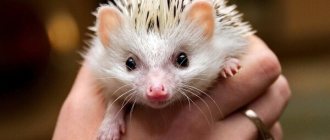Review author: “ZooVita”
Rabbits are unpretentious animals. They reproduce well and grow at home. There are more than two hundred breeds of these furry animals all over the world. They are raised for their meat and fur. There are also decorative breeds. Animals raised for meat are usually kept outdoors.
What is the difference between a dwarf rabbit and a decorative one?
So that, as an adult, the rabbit does not surprise you with its size, you should ask the seller for a certificate
People often wonder: what is the difference between dwarf rabbits and decorative ones. First of all, these are the sizes. When ornamental animals grow up, they can become very large.
But in childhood, all rabbits are small, and it is difficult to independently distinguish a dwarf individual. To avoid mistakes, you need to ask the seller or breeder to present a certificate or show the parents of the future pet.
For the beginning farmer
In accordance with many years of experience in rabbit breeding in our country, it is considered rational and economically feasible to breed those breeds that are most common in the farmer’s area of residence.
This significantly simplifies the issue of repairing the herd, and novice rabbit breeders will have someone to learn from in keeping rabbits at the initial stage of farming.
- Choosing the best rabbit breeds is a responsible undertaking.
- Before making a decision, it is important to have a good understanding and be able to distinguish the individual characteristics of the breeds.
- Once the farmer has made his choice, he needs to wisely purchase the initial stock, since the health and productivity of the entire future herd depends on its quality.
- To be successful in rabbit breeding, the initial stock must have high genetic potential.
Therefore, it is not enough to make a choice based on a photo of a rabbit breed, but it is better to consult with more experienced farmers or breeders whom you trust.
Breeds and general description
You will be surprised, but this is exactly what a dwarf ram looks like
When the decision to have a dwarf rabbit has been made, you need to decide on the choice of breed. Such animals are colored and white, and their weight ranges from 700 g to 3 kg.
The following breeds can be found in nurseries and pet stores:
- Dwarf ram;
- Dwarf rex;
- Foxy dwarf rabbit;
- Angora dwarf rabbit;
- Japanese dwarf rabbit;
- Dwarf hare;
- Dwarf rabbit Hermelin;
- Dutch dwarf rabbit.
Angora rabbits are particularly fluffy
Both the appearance and character of the animals depend on the purity of the breed. Some long-eared ones resemble a ball and are very peaceful, while others have rather short fur and a more aggressive character. So, first of all, the animal must evoke sympathy.
Giant rabbits
If decorative rabbits are distinguished by their miniature size, their exact opposite are giants - breeds that reach 8-10 kilograms.
Flanders breed
Some of them even record the largest rabbit in the world, weighing about 30 kilograms. The most common breeds of giant rabbits are:
- Flanders is one of the oldest breeds. These rabbits are bred for both meat and skins. They are distinguished by high fertility and intensive growth. From one animal you can get more than 5 kilograms of clean meat. The size of an adult individual directly depends on the conditions of detention and the quality of food. Newborn rabbits already gain up to three kilograms of weight in the first 1-1.5 months. Breeding Flanders is profitable in terms of the amount of the final product. In addition, it is worth noting that these rabbits are omnivores and are not capricious in their care.
- The Belgian giant reaches up to 12 kilograms in weight. Just like his previous relative, he is a mixed breed. The ears of a representative of this breed are up to 20 centimeters. The meat is tender and tasty, does not cause allergies and is used for dietary nutrition.
Breeding giants is profitable on the one hand, and difficult on the other. Such animals require stronger cages and queen cells, more food and frequent cleaning.
Pros and cons of content
Dwarf rabbits are affectionate and clean, but very susceptible to disease
There are advantages and disadvantages to owning these small, cute animals. Let's start with the pros:
- Cleanliness. Dwarf long-eared cats quickly become accustomed to the litter box, and there is very little litter from them in the apartment.
- These are affectionate, kind pets that immediately become attached to their owners. When they are happy, they click their teeth funny and make pleasant sounds.
- Rabbits are unpretentious in care and nutrition, and their maintenance is quite inexpensive.
The main disadvantage of animals is their pain. They can fall ill not only from infection, but also from sadness. Frequent visits to the veterinarian can take a lot of effort and time. Another disadvantage is the problem of constantly gnawing on something. Buying toys will help solve the problem: the rest of the things in the house will remain intact.
It is also worth considering that each rabbit, despite its small stature, is a personality. They are very touchy and remember bad treatment for a long time.
Rex
These representatives of decorative rodents are also known as royal rabbits. The short fur of the animals has a shiny color that looks like velvet, which makes it seem like they are wearing a kind of palace cape. Today, Rex rabbits have the most numerous choice of colors.
Miniature animals are representatives of not the smallest breed of rabbits. The weight of a healthy individual typically reaches a mass of 1500 grams. The pointed shape of the head, exquisite antennae and ears directed upward at an angle of 45 degrees are the distinctive features of this decorative animal.
Rex rabbits of any age have an affectionate and kind character. But a cute rodent is not able to respond to a nickname and cannot have much affection for its owner.
Care and maintenance at home
Keeping long-eared pets is not particularly difficult. It is important to choose a healthy animal and prepare a suitable room for it. It should be well ventilated, but without drafts. Heat is also contraindicated for rabbits; they cannot be placed near a radiator.
It is better to buy a cage with galvanized metal rods. Two males will not get along in it, but females or rabbits of different sexes can be placed together. Of course, the size of such a house should be larger.
Many breeders are afraid of unpleasant odors. If you properly care for animals, they will not exist. At the bottom of the cage, it is necessary to pour bedding from pieces of newspapers, sawdust or straw in time. These materials absorb odors well and can be quickly removed.
Long-eared dogs with thick hair need to be brushed regularly. In addition, approximately once every 3 weeks your pet needs to have its claws trimmed.
What to feed a dwarf rabbit
Dwarf rabbits can eat up to 30 times a day
Dwarf rabbits are big eaters: they eat up to 30 times per day. The owners must provide them with adequate nutrition and not restrict food, otherwise they can harm the digestive system. The food that the animal eats is quickly digested and reaches the intestines only after the next meal.
A pet's diet should be varied. It is better if it is based on ready-made balanced food from pet stores. You can also give hay. If the eared dog refuses to eat it, the hay is slightly moistened with water and salt.
The menu must be supplemented with grass, including meadow grass, as well as bone meal and chalk - a long-eared animal cannot do without minerals. It is useful to give oats or wheat soaked in water, fresh fruits and vegetables.
Important: You can give cabbage, which rabbits love, but red cabbage is contraindicated for them.
Sometimes rabbits eat the waste left in the cage. There is no need to be afraid of this: they are harmless to long-eared animals.
Hygiene and bathing
You should only bathe babies if they are very dirty.
Since dwarf rabbits are very clean, there is no need for regular bathing. But if the baby gets very dirty at home or on a walk, it is better not to let him clean himself, but still give him a bath. The rest of the time, you should not expose your baby to stress. He will take care of his own skin, which is also replaced with a new one every six months.
Diseases and treatment
Vaccines and vaccinations are necessary for dwarf rabbits. These gentle creatures, even in comfortable room conditions, can catch a disease such as a cold or conjunctivitis. Both hypothermia and heat stroke are equally dangerous for them. Timely vaccinations will protect rabbits from infections and dangerous diseases such as rabies.
Therefore, the condition of pets must be constantly monitored. The following symptoms may indicate the disease:
- Vomiting, nausea, bloating.
- Loose stools or constipation.
- Belching, rumbling in the stomach, bad breath.
- Fatigue, lethargy, drowsiness.
Even if there are one or two symptoms, the baby should be shown to the veterinarian: delay can be disastrous for him.
Vaccination
The smallest rabbits are protected from diseases by maternal immunity. When they switch to adult food, the body weakens. Vaccinations can begin as early as the sixth week. Animals are vaccinated against rabies, salmonellosis, listeriosis and some other diseases.
Before vaccination, you need to prepare: take care of the prevention of helminthic infestation, monitor the pet’s health, and stop bathing it a week before.
Selecting a cage and accessories
Take care in advance of entertainment for the rabbit in the cage
The dwarf rabbit is a delicate and fragile breed, which must be taken into account when choosing a cage. It is desirable that each individual has its own house. Its size must be 4–5 times the size of an adult rabbit so that the animal can move. It is advisable that its rods be made of unpainted iron: when the baby gnaws on them, his health will not suffer . It is better to choose a plastic pallet.
It is worth taking care in advance about purchasing accessories: tray, feeder, drinking bowl, toys. You also need to buy a manger into which hay will be poured. This is necessary because it quickly deteriorates on the floor.
The benefits of rabbit meat
In addition to valuable warm and hypoallergenic down, rabbits have valuable meat. This is not surprising, because it has many advantages:
- Rabbit meat contains little animal fat - cholesterol, which often becomes the main cause of disruption of intracellular metabolism and the development of atherosclerosis. This is a pathology of the vascular system, which occurs due to fatty deposits localized in the vessel. Because of them, blood circulation is disrupted and many problems arise - lack of oxygen, increased blood pressure, disruption of the heart muscle, and so on.
- Rabbits do not absorb pesticides used on plants. That is, this is the only animal whose meat does not contain poisons if it eats a processed product.
- Due to the high content of useful substances, rabbit meat reduces the radioactive effect on humans. Thus, it is recommended to take rabbit meat during chemotherapy and during the post-rehabilitation period in order to slightly protect your body.
- Meat is rich in proteins, which are absorbed almost completely.
Based on the above, we can conclude that rabbit meat, in comparison with the meat of other animals, is dietary and very healthy. That is why it is often used to feed small children who cannot eat fatty pork or beef. Rabbit meat is also ideal for people with gastrointestinal problems, as it does not cause irritation to the mucous membranes, is easily digestible and is quickly digested.
With constant use of rabbit meat, you can significantly improve your appearance and health. Fats, carbohydrates, vitamins, antioxidants affect all aspects - improve the functioning of all organs, strengthen the cardiovascular system, help strengthen nails, hair, bones, and take part in the elimination of facial wrinkles.
Varieties of breeds - on video:
Breeding dwarf rabbits
When breeding rabbits, the key is moderation.
A feature of decorative rabbits is the possibility of early mating. They reach sexual maturity in 6–9 months. At this time, the animals are ready to reproduce. At one time, a female rabbit brings on average 5–7 babies. Breeding rabbits too often is not recommended, as this may affect the quality of the offspring.
How to determine the sex of an animal
Rabbits aged one to two months are practically indistinguishable from each other. The sex of animals can only be determined from documents. The genitals will help determine it externally. The animal must be placed with its belly up on its hind legs. After this, the tail is raised and the genital organ is gently squeezed. The male will have a penis, while the female will have a pink triangle.
Mating and pregnancy
Be prepared that a female rabbit ready for mating will dramatically change her behavior
It is best to breed a dwarf rabbit under the age of one year . When she is ready to breed, her character changes dramatically. The female becomes restless and irritable. At this time, it’s time to place her in the male’s cage, where she will become more docile. Mating occurs almost immediately. Then the animals need to be left alone for a while, and then seated. A day after this, control mating occurs.
Pregnancy in females lasts on average 31 days. If the litter is small and the offspring are large, it may last longer. When there are many rabbits, their mother will give birth faster.
During the first two weeks, the female's diet does not need to be changed. Starting from the third week, the dose should be increased slightly. The menu of the expectant mother should include fruits and vegetables, especially cucumbers: they are believed to enhance lactation. But you still shouldn’t overfeed your rabbit.
How to care for newborn dwarf rabbits
Rabbits are born deaf, blind and require special care. Their mother will look after them, and the owners must provide her with conditions and additional food. It is necessary to prepare a warm place for the offspring in advance: if the rabbits are placed on the floor, they will die.
There is no point in disturbing the rabbit again: she may get scared and harm the newborns. But you will have to make sure that she is always full and does not eat the babies. There is no need to worry that the female spends little time with the children. Unlike dogs and cats, rabbits do not sit with their offspring all the time, but only come to feed them.
Hermelin
This representative of the smallest breeds of rabbits is called not only Hermelin, but also the Polish rabbit or ermine. The rodent has a difficult fate, because initially such an animal was raised for the purpose of obtaining fur and skins that are similar to ermines. It was later that this type of rabbit became exemplary for home keeping.
The color of the hermelin's two-centimeter hair, skin and claws is exclusively bright white. The Polish rabbit's eyes can be blue or red. The body length can reach 34 centimeters. The average healthy weight of an adult hermelin can vary between 800-1600 grams.
The thick coat of the Polish rabbit creates discomfort and even intolerance for its owner in hot climates. The character of the Hermelins cannot be called pleasant. Males are lazy and do not like to be touched unless they want it. Females are not averse to having fun and running around, but sometimes they overact to the point of aggressiveness. Therefore, it is recommended for trained rabbit breeders to keep such pets.
Training and playing with your pet
Decorative rabbits just love to play
Dwarf rabbit breeds love to play and can learn some interesting tricks. They perceive training not as coercion, but as an opportunity to have fun. To achieve success, you need to eliminate negativity and aggression from the educational process. The best assistants in training will be praise and treating your pet with treats.
You should not start training your baby immediately after purchase. We need to give him a couple of months to adapt, after which he can begin training.
Colored dwarf
One of the smallest decorative rabbits is also known as the short-haired dwarf. The weight of a healthy representative of this species can be from 800 to 1500 grams. The length of the erect ears of an adult is approximately 5 centimeters.
The initial color of the fur coat of the bred rabbit was light gray. Today on the market for decorative rodents you can find more than 60 colors: from all shades of gray to bright yellow and orange. The big advantage of this dwarf representative is its neat hairline, which does not require special care.
At one and a half years old, this type of rabbit begins the stage of puberty, during which the pet can be overly aggressive, so experts advise not to spare the animal from sterilization or castration. Then this cute animal will constantly delight its owners with affection and tenderness.
How to toilet train an animal
Accustoming a baby rabbit to a litter tray requires a lot of patience from the owner.
The little rabbit is gradually getting used to the toilet, but you will have to be a little patient. It is advisable to remember in which corner the breeder had the tray and place it there at home. It is worth asking the breeder for some used litter and mixing it with the old one. The pet will quickly find its native smell.
If the baby doesn't get into the tray, there's no need to swear. As soon as it becomes noticeable that your pet wants to go to the toilet, you must immediately put him in the litter tray. After a job done successfully, the animal should be praised. If you patiently train your pet to use the toilet day after day, the result will be achieved.
Bathing
Some experts say that proper care for a lop-eared rabbit involves bathing it constantly. At the same time, other experts note that such procedures do not need to be carried out, since the rabbit is able to independently keep its fur clean. The main thing is that his cage is also clean.
Important! If you decide to bathe your pet, you should use only warm water.
In order for an animal to live in comfort, it is necessary not only to ensure the cleanliness of its cage and tray, but also to periodically let it go for walks around the room. The rabbit should walk every day for 2-3 hours. When choosing a place for walking, you need to make sure that there are no things there that can injure the rabbit or that it can chew.
See also All about rabbits Poltava silver
You also need to remember that this breed of rabbits is very sociable. They need constant attention. In this case, the animal will respond with affection and love to its owner.
What to name a dwarf rabbit
Choosing a name for these affectionate creatures is not an easy task, because you want your pet to have the most beautiful one. At home, rabbits are called completely differently than on farms.
The name has a certain influence on the character of the pet. A rabbit whose nickname sounds soft has a more docile character than an animal with a harsh name. When choosing, you can take into account body type, color, and other appearance features.
For boys, the names Coal, Ryzhik, and Donut may be suitable. Popular rabbit names are Yasha, Fomka, Stepan. Female rabbits readily respond to the nicknames Bunny, Smokey, Pushinka. Girls with a proud, unapproachable character are given names such as Eva, Gerda, Magnolia.
To quickly accustom your baby to his name, you need to call him as often as possible . If the name is sonorous and short, there will be no problems.
Dutch dwarf
This dwarf breed of ornamental rodents was bred in Holland in the mid-twentieth century. Since 2014, rabbit breeders from Russia have also been breeding this type of rabbit. This is truly the smallest rabbit in the world. Its standard weight, according to the specialized British Council, should not exceed 1100 grams. The length of the standing ears is 5-7 centimeters. Eye color varies from brown to blue.
According to many fans of the dwarf Dutchman, its color resembles a tuxedo - just as stylish and elegant. The color range of the decorative breed's fur is extremely diverse. Dutch dwarfs can be blue, chocolate, chestnut, pearl, orange and others.
The character of the rodent is flexible and friendly. He gets along well with children and adults.
Soviet chinchilla
This breed was developed by crossing a white giant and a French chinchilla rabbit. On average, such rabbits weigh 4-5 kg. They also have developed muscles and grow well in the first 4 months. Their moire fur is dark gray with a blue tint.
The female brings 7-8 babies in a litter.
The breed is very early maturing, very unpretentious, and not afraid of frost.
Black-brown rabbit
A description of meat rabbit breeds would not be complete without mentioning the black-brown rabbit - a breed obtained by crossing the Belgian Flanders, the white giant and the Vienna blue. The resulting animal acquired very fluffy black-golden fur.
Rabbits at home - breeding, keeping and raising rabbits from A to Z. 125 photos and videos of domestic breeds and farm arrangementRabbit skin - dressing, necessary materials, storage and tailoring features (150 photos)
Breeding rabbits: profitable or not? Business plan and advice for beginners on how to make money from rabbits (120 photos + video)
These rabbits have a body up to 60 cm long and weigh up to 6 kg.
The breed is early maturing and prolific: the female gives birth to at least 6-8 rabbits.
Health
In addition to proper care, the lop ear also requires regular examination by a veterinarian. Diseases usually affect the animal's ears and eyes. Therefore, it is necessary that only a specialist examine him.
The problem here is that rabbits of this breed are unable to shake their heads. It is for this reason that discharge constantly accumulates in their nose, ears and eyes. As a result, the animal may experience inflammation due to the accumulation of excess such secretions. It is also recommended to regularly clean the animal’s ears and rinse its eyes.
